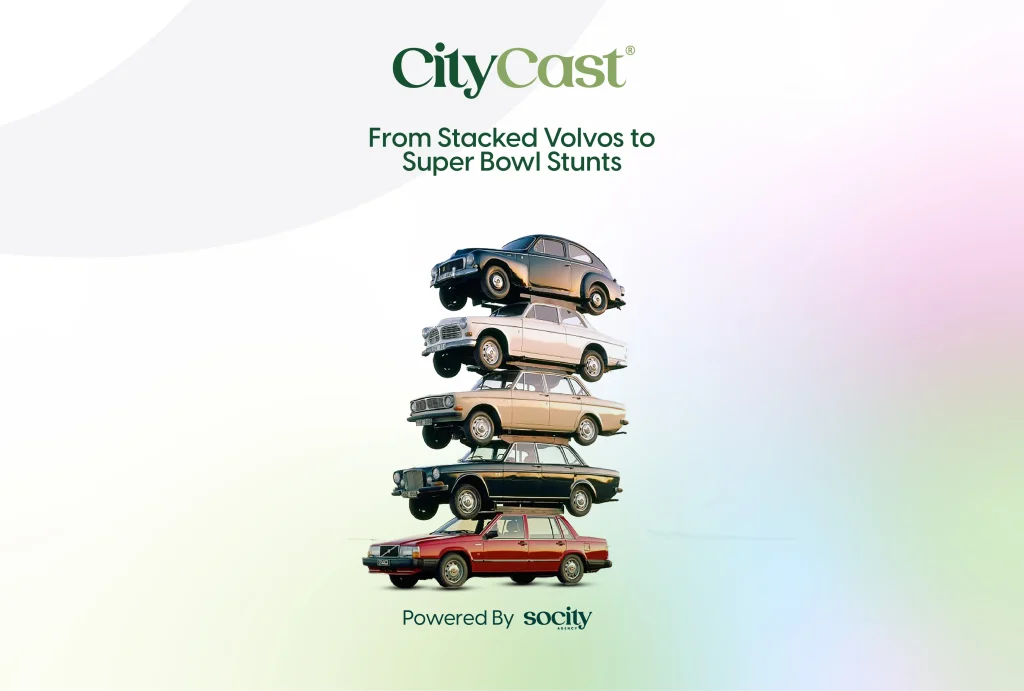
How often do you see a Volvo strolling around on the streets of Addis? Not much, right!! But Volvo has implemented brilliant advertising and branding techniques that have made it very popular in Western media and Western markets. Well, why do we need to talk about Volvo then? Because Volvo’s marketing practices are noteworthy as they exemplify the role of brand differentiation and innovative advertising in business growth. In order to understand how Volvo has managed to establish a name for itself we need to go all the way back to the first Volvo car. The first Volvo automobile, the ÖV4 (Öppen Vagn 4 cylinder), left the small Swedish town of Gothenburg on April 14, 1927. The original model was designed to survive the severe weather in Sweden, which laid the groundwork for Volvo’s future durability. Volvo’s dedication to its brand has allowed it to make immense strides in the industry.
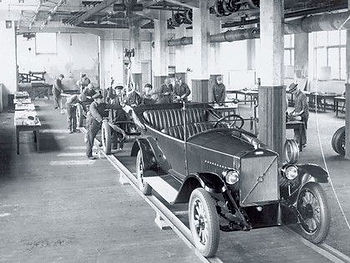
Here is the thing about Volvo’s brand essence—Volvo seems to be obsessed with safety. No other brand is as committed to a single word as Volvo is to safety. For Volvo, safety is ingrained in everything they do, not just a claim or demonstration in TV commercials. When it comes to safety, Volvo was well ahead of its time in the market. Volvo pioneered the safety angle in the 1940s and went on to become fully fixated on it during the 1960s, long before customers gave any attention to it and when nobody was using seatbelts. However, since then, the market has caught up. How much of a priority do you place on safety when purchasing a car? Data from Statista’s Global Consumer Survey indicates that safety and fuel efficiency were the top priorities for prospective American consumers (with positions shifting from 2018) at 56 and 55 percent respectively.
This is how important safety is to Volvo. Volvo invented the three-point seat belt in 1958. Volvo felt so strongly about the invention that they chose to share it with all the other automakers, even though they had a patent they could have used to enforce and make millions of dollars. That demonstrates Volvo’s conviction and sincerity quite well. Volvo has always been far ahead of automotive safety standards. In reality, when consumer concerns about safety increased, regulators adopted what Volvo was doing as the gold standard and forced other businesses to follow suit. Additionally, Volvo introduced side airbags and airbags ahead of schedule in the 1990s. With the advent of TV ads, we became accustomed to watching Volvo’s crash test dummy commercials, which reinforced its superiority in terms of safety. Volvo has remained the industry leader in terms of safety. More than any other automaker, Volvo had three models included in the Top Safety Picks of the 2012 IIHS (Insurance Institute for Highway Safety). The 2012 Volvo V40 also received the highest grade of five stars in the Euro NCAP crash test, indicating that it is the greatest automobile the company has ever tested.
The main question is, how does Volvo communicate its steadfast dedication to be the market leader in terms of safety? You need not look no further than their advertising and marketing strategies. Volvo allocates between five and six percent of its revenue to selling costs, which include advertising and marketing. Volvo regularly participated in integrated marketing initiatives, utilizing both traditional and digital media to their fullest capabilities. Let’s even start with their logo. In homage to the company’s metalworking heritage, the recognizable Volvo logo is the Alchemical sign for IRON. Although the original logo was simple, Volvo adopted the Iron symbol in 1930 and experimented with several iterations of the design throughout the years.
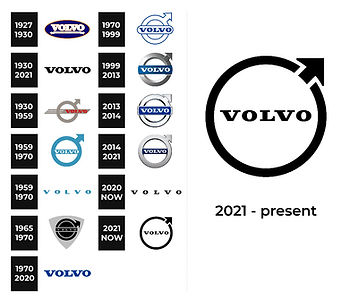
Volvo incorporates safety into its brand criteria from the very beginning. The brand mission statement for Volvo is as follows: “Nobody should die or be seriously injured in a Volvo.” That demonstrates their intense attention to the future of the Volvo brand and their obsession with safety over the past 70 years! The initial seven seconds that a consumer is exposed to a brand are crucial because they are subjected to 5,000 brand messages every day. Customers are bound to move on from a brand if it cannot quickly capture their attention.
The central message in advertising Volvo are as follows:
- Showcase impossible things using Volvo Technology & Creativity. Be Bold.
- Value Family’s bond & showcase the importance of safety.
- Value Life & Diversity.
- Aspire to do great things. Believe in yourself.
- Consumer centricity.
Here are a few strategies implemented by Volvo along with noted campaigns from 2020 that showcase the central message in Volvo’s advertising.
- Volvo is adept at pushing the limits of advertising. One of the most spectacular commercials ever is Van Damme’s “Volvo Epic Split,” in which the actor does a real, authentic split between two Volvo trucks driving backward.
- If you think the Epic Split is unbeatable, watch this incredible stunt by a Volvo vehicle holding three trucks on its shoulder to create a tower of trucks, with the company’s president, Roger Alm, standing at the top. Everything was real. (Old Volvo advertisements on car towers served as inspiration.)
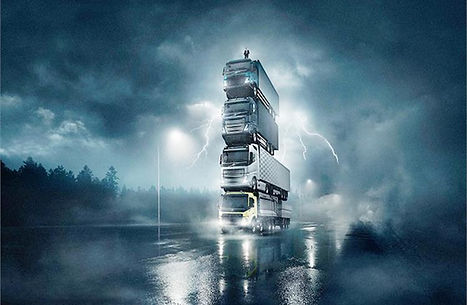
- The Flying Passenger Campaign highlights Volvo trucks’ superior technology and fuel efficiency. In this instance, Volvo strapped its truck with a paraglider at the back while it was going uphill.
- This heartfelt short film-style advertisement, which depicts a small girl’s life path with an almost anti-climactic ending, is bound to make you teary-eyed.
- Volvo launched the “For Life” campaign in 2023 with a lovely short film that urged viewers to confront their fears while astutely pointing out the value of safety in the process.
- “The Day the Ocean went Away” is a beautiful book that Volvo released with an emphasis on children and the environment. Activating brand equity among future customers is a smart move on Volvo’s part.
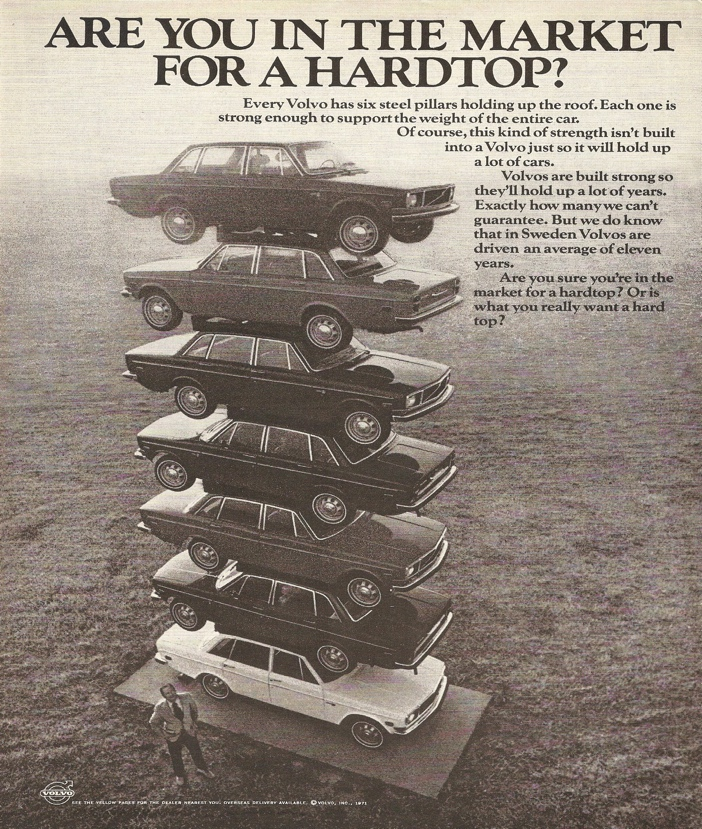
These are recent examples but Volvo’s impeccable tactics go all the way back to the 60’s.
When the Volvo 140 series was first released in 1966, it was perhaps the model for what a modern automobile should look like: compact and dependable with a strong engine and a cozy cabin. The Volvo was a breath of fresh air compared to the gas-guzzling vessels that were then roaming American roadways. Volvo capitalized on this by showcasing the functionality and safety of its vehicles in an interesting and engaging manner. The above advertisement with the well-known stacked Volvos was actually an accident. Due to water damage, the cars in question could not be sold. It was suggested that they stack them on top of one another to highlight Volvo’s outstanding craftsmanship and renowned “safety cage” integrated into the passenger cabin.
All of Volvo’s vehicles of the 1970s came equipped with a dual-circuit triangulated backup braking system and four-wheel disc brakes, which was a significant benefit. This implied that you would still have brakes on three of the four wheels in the event that one of the brake lines broke. This was in stark contrast to US cars, where even high-end models usually had a front disc/rear drum combination.

As you may very well be aware of, the superbowl is the biggest US media events of the year where companies try to outdo each other using TV ads. Can you imagine what Volvo did for the 2023 superbowl? Volvo wanted to stand out from the competition. They wanted to raise brand recognition and demonstrate their commitment to their clientele. Their plan was to take advantage of the Super Bowl advertising momentum and launch a captivating Twitter campaign to draw in clients. Volvo was able to present its brand to a large audience in this way. To enter, people simply needed to tweet using the hashtag #VolvoContest and nominate a loved one when a commercial for another automaker was broadcasting during the Super Bowl. Following their correspondence with the brand, participants completed a brief nomination form outlining their nominee’s qualifications for a brand-new Volvo XC60. Volvo was also able to reap numerous more benefits from its robust social media presence and Twitter campaign. More than 230 million impressions totaling more than $44 million were obtained by the campaign. The #VolvoContest hashtag was the most used automotive-related hashtag during the Super Bowl, and there were over 114,000 mentions of Volvo on Twitter.
Volvo’s marketing and advertising strategies have undeniably positioned the brand as a leader in automotive safety while showcasing innovation and creativity. Through its commitment to safety, bold advertising campaigns, and consumer-centric approach, Volvo has not only differentiated itself in the market but also established a lasting connection with its audience, setting a benchmark for the industry.